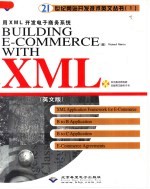

用XML开发电子商务系统 BUILDING E-COMMERCE OITH XMLPDF电子书下载
- 电子书积分:11 积分如何计算积分?
- 作 者:(美)Richard Martin文本著作者
- 出 版 社:北京:北京希望电子出版社
- 出版年份:2001
- ISBN:790005636X
- 页数:258 页
PART ONE Introduction to e-business,and XML 1
CHAPTER 1 XML and e-business applications 2
1.1 About e-business 3
1.1.1 Business transformation and innovation 5
1.1.2 Which is the e-business value? 7
1.1.3 A simplified classification schema for e-business applications 7
1.2 The Extensible Markup Language(XML) 13
1.2.1 World Wide Web document standards 14
1.2.2 A brief history of XML 14
1.2.3 XML-a universal data format 15
1.2.4 A short comparison of XML and HTML 16
1.2.6 Advanced type definitions 18
1.2.7 Metadata(RDF and PICS) 18
1.2.5 XML linking and addressing 18
1.2.8 Domain-specific document definitions 19
1.2.9 XML in wireless apphcations 20
1.2.10 XML styling and transcoding 21
1.2.11 XML query languages 21
1.2.12 Processing XML documents 22
1.2.13 Organizations concerned with XML 25
1.2.14 Typical applications 26
1.3 XML and e-business 27
1.4 Summary 29
CHAPTER 2 Introduction to IBM e-business solutions 30
2.1 IBM e-business cycle 31
2.2 IBM Application Framework for e-business 33
2.2.1 Using an asset-based approach 34
2.2.2 Overview of the IBM Application Framework 37
2.2.3 Patterns for e-business 45
2.3 Summary 50
CHAPTER 3 XML in the IBM Application Framework for e-business 53
3.1 e-business application with XML 53
3.2 IBM XML development tools and utilities 56
3.2.1 Open source initiative:the xml.apache.org project 58
3.2.2 Parsers 60
3.2.3 Editing 61
3.2.4 Formatting 66
3.2.5 Programming 69
3.3 XML open frameworks 73
3.3.1 OASIS consortium,XML.ORG 73
3.3.2 Electronic Business XML initiative(ebXML) 74
3.3.3 WebSphere B2B Integrator 75
3.4 XML extensions to IBM products 78
3.4.1 WebSphere Application Servers 79
3.4.2 VisualAge for Java 85
3.4.3 MQSeries Integrator 85
3.4.4 DB2 XML Extender 86
3.4.5 Lotus with XML 88
3.4.6 Tivoli Cross-Site 90
3.5 Summary 91
PAPT TWO Designing B2C and B2B e-business applications using XML 92
CHAPTER 4 Patterns for B2C and B2B applications 94
4.1 Definitions 95
4.1.1 Logical and physical patterns 95
4.1.2 Runtime topology nodes 96
4.2 e-business patterns for B2C applications 98
4.2.1 B2C logical patterns for e-business 98
4.3 e-business patterns for B2B applications 103
4.3.1 B2B logical patterns for e-business 104
4.3.2 Physical patterns for B2C and B2B runtime topologies 112
4.4 Implementation considerations for XML 113
4.4.1 Applications that benefit from using XML 114
4.4.2 Typical design for applications using XML 115
4.4.3 A sample of an architecture for XML applications 116
4.4.4 Composing Java object with XML 118
4.4.5 XML filtering with Java servlets 119
4.4.6 XML/XSL as inputs for a Web application generator 119
4.4.7 Performance 119
4.4.8 Security 120
4.5 Summary 120
CHAPTER 5 B2C applications using XML 122
5.1.1 The field of business-customer interaction 123
5.1 The B2C application model 123
5.1.2 Application models,architectures and compoents 124
5.1.3 XML powers the B2C interaction 127
5.2 Enterprise portals 128
5.2.1 Data and application integration 129
5.2.2 Content management 131
5.2.3 Controlled access to structured information 133
5.2.4 Customer relations,recognition,and personalization 134
5.2.5 Business intelligence and enterprise portals 137
5.2.6 Connection to e-commerce 138
5.2.7 New presentation devices 141
5.2.8 IBM portal examples 143
5.3 IBM products and tools in B2C applications 146
5.3.1 Enterprise Information Portal 146
5.3.2 Lotus Raven suite 148
5.3.3 IBM WebSphere 150
5.3.4 IBM products and tools in portals 153
5.4 Summary 154
CHAPTER 6 B2B applications using XML 156
6.1 The B2B application model 157
6.1.1 B2B:a major business opprtunity of business integration 158
6.1.2 General issues in business-to-business electronic interactions 159
6.1.3 XML B2B frameworks and standards 160
6.2 IBM WebSphere B2B Integrator 164
6.2.1 Trading Partner Agreements 164
6.2.2 The IBM Business-to-business Protocol Framework 181
6.2.3 A sample application TPA 187
6.2.4 Using the IBM Visual XML Builder for a specific OBI TPA 190
6.3 Summary 207
PART THREE B2B eMarketPlaces 210
CHAPTER 7 B2B eMarketPlaces:a case study 212
7.1 Why the B2B eMarketPlace application? 213
7.2 eMarketPlaces and online intermediaries 214
7.2.1 B2B online intermediary business trading models 216
7.3 The E-broker application 217
7.3.1 E-broker business models 218
7.3.2 Considerations on the impact of XML on the architecture 226
7.3.3 A building block architecture 230
7.3.4 E-broker application functional decomposition 232
7.4 Initial E-broker design activities 238
7.4.1 E-broker access service TPAs 238
7.4.2 The directory service data model in DB2 XML Extender 241
7.5 Summary 245
APPENDIX A An example of a OBI TPA XML document 246
A.1 The OBI TPA between Large Coand pens We Are 247
- 《电子测量与仪器》人力资源和社会保障部教材办公室组织编写 2009
- 《少儿电子琴入门教程 双色图解版》灌木文化 2019
- 《商务英语口译教程 第3版》朱佩芬,徐东风编著 2017
- 《实用商务英语听说 第1册》窦琳,江怡平主编 2019
- 《英语实训教程 第2册 商务英语听说》盛湘君总主编 2019
- 《通信电子电路原理及仿真设计》叶建芳 2019
- 《电子应用技术项目教程 第3版》王彰云 2019
- 《近代民营出版机构的英语函授教育 以“商务、中华、开明”函授学校为个案 1915年-1946年版》丁伟 2017
- 《潜文本的阐释与翻译》刘早著 2019
- 《手工皮艺 时尚商务皮革制品制作详解》王雅倩责任编辑;陈涤译;(日)高桥创新出版工坊 2019
- 《SQL与关系数据库理论》(美)戴特(C.J.Date) 2019
- 《魔法销售台词》(美)埃尔默·惠勒著 2019
- 《看漫画学钢琴 技巧 3》高宁译;(日)川崎美雪 2019
- 《优势谈判 15周年经典版》(美)罗杰·道森 2018
- 《社会学与人类生活 社会问题解析 第11版》(美)James M. Henslin(詹姆斯·M. 汉斯林) 2019
- 《海明威书信集:1917-1961 下》(美)海明威(Ernest Hemingway)著;潘小松译 2019
- 《迁徙 默温自选诗集 上》(美)W.S.默温著;伽禾译 2020
- 《上帝的孤独者 下 托马斯·沃尔夫短篇小说集》(美)托马斯·沃尔夫著;刘积源译 2017
- 《巴黎永远没个完》(美)海明威著 2017
- 《剑桥国际英语写作教程 段落写作》(美)吉尔·辛格尔顿(Jill Shingleton)编著 2019
- 《电子测量与仪器》人力资源和社会保障部教材办公室组织编写 2009
- 《少儿电子琴入门教程 双色图解版》灌木文化 2019
- 《指向核心素养 北京十一学校名师教学设计 英语 七年级 上 配人教版》周志英总主编 2019
- 《北京生态环境保护》《北京环境保护丛书》编委会编著 2018
- 《指向核心素养 北京十一学校名师教学设计 英语 九年级 上 配人教版》周志英总主编 2019
- 《通信电子电路原理及仿真设计》叶建芳 2019
- 《高等院校旅游专业系列教材 旅游企业岗位培训系列教材 新编北京导游英语》杨昆,鄢莉,谭明华 2019
- 《电子应用技术项目教程 第3版》王彰云 2019
- 《中国十大出版家》王震,贺越明著 1991
- 《近代民营出版机构的英语函授教育 以“商务、中华、开明”函授学校为个案 1915年-1946年版》丁伟 2017
